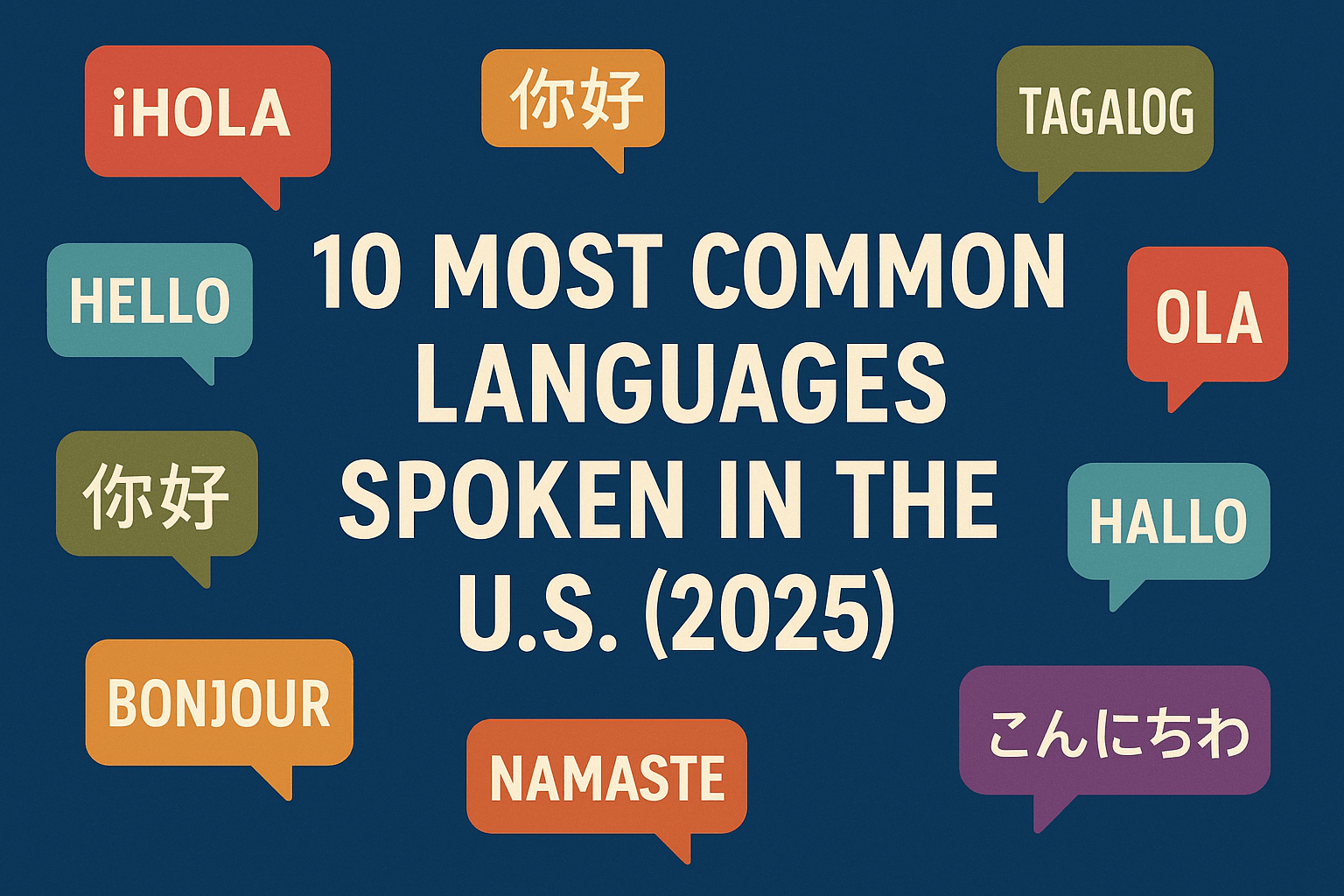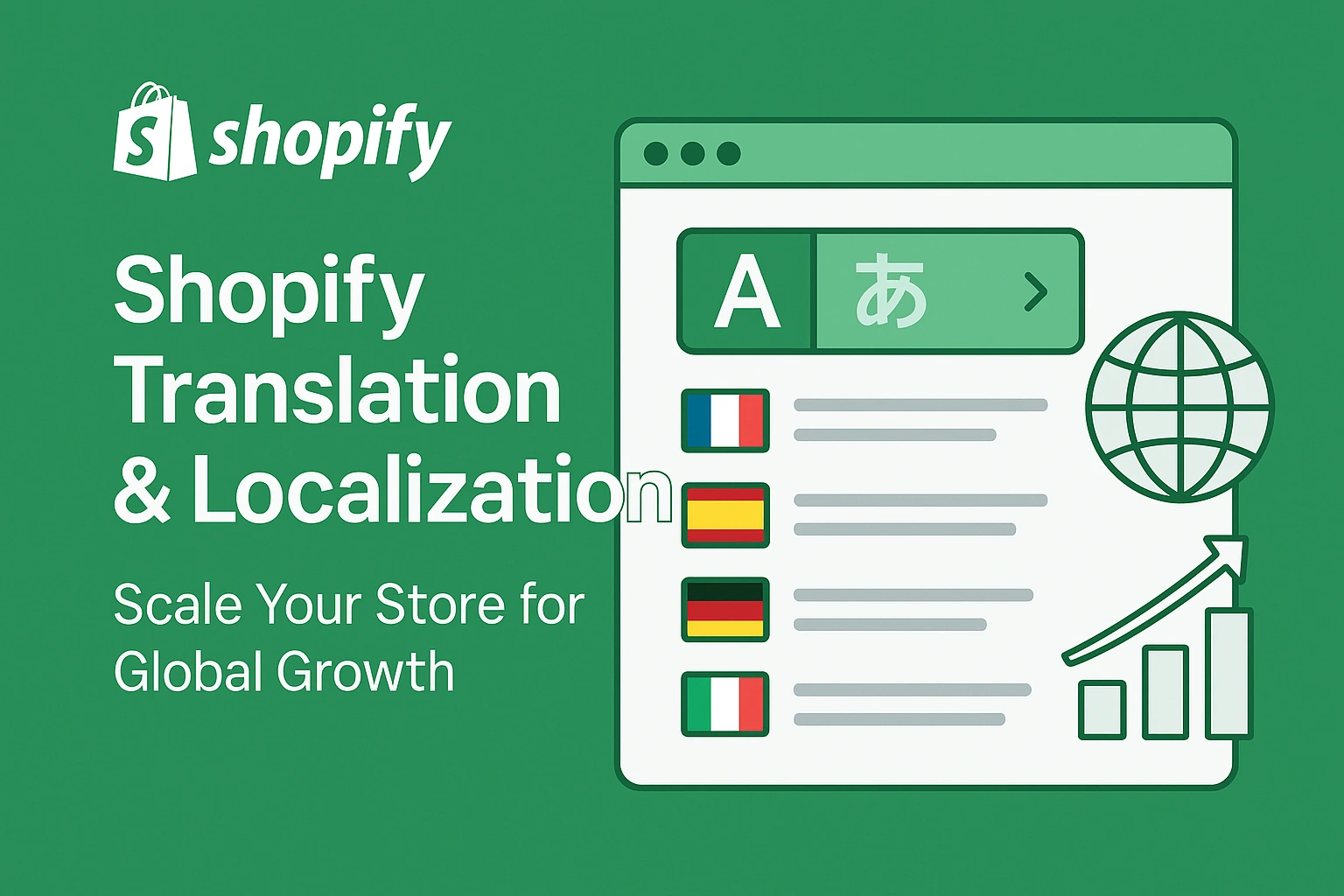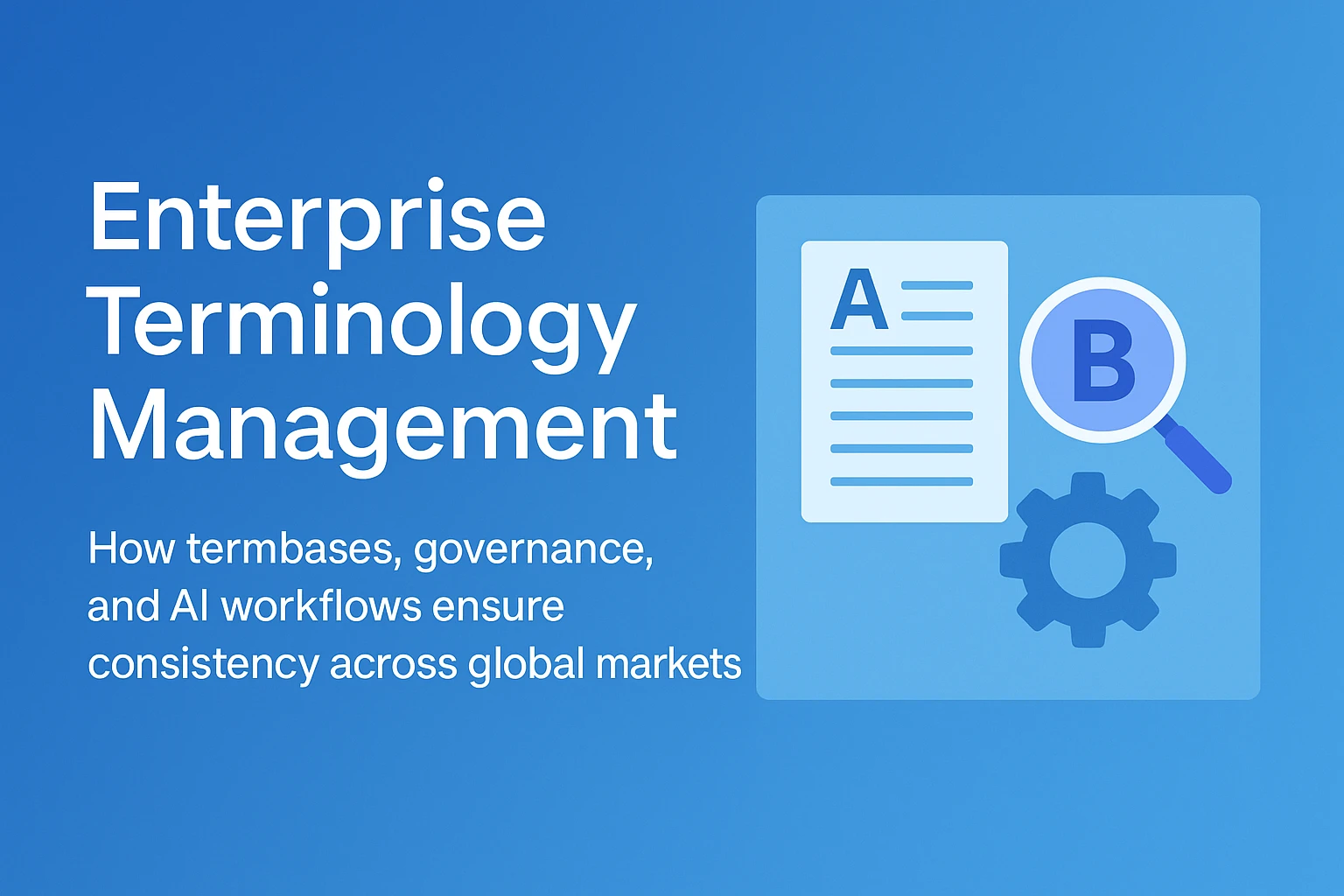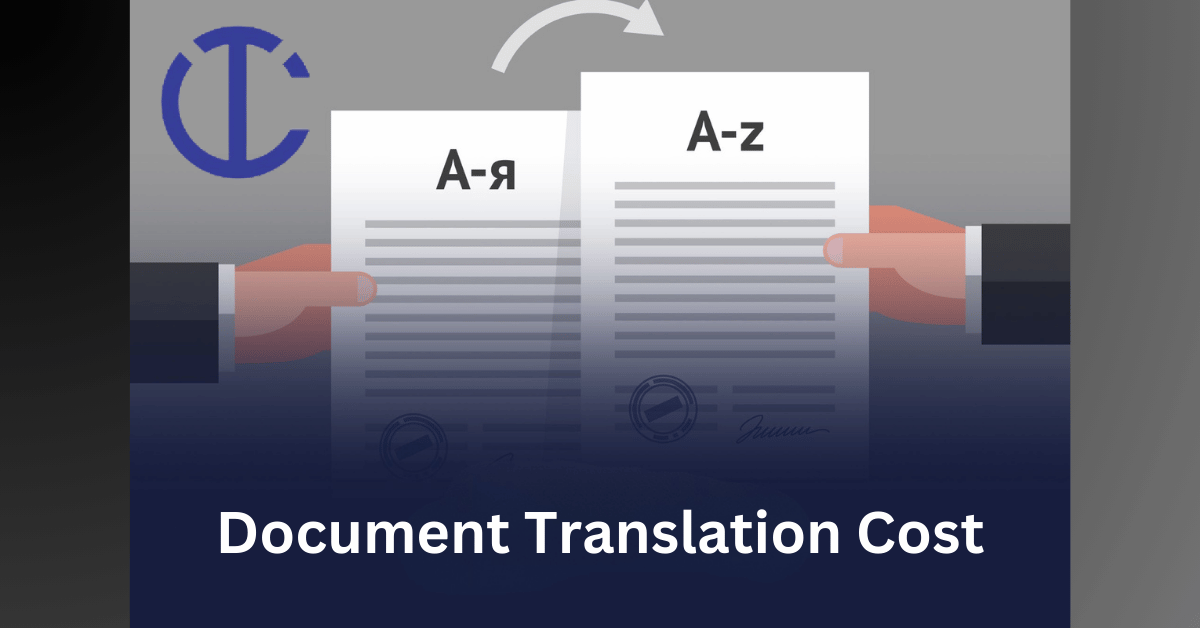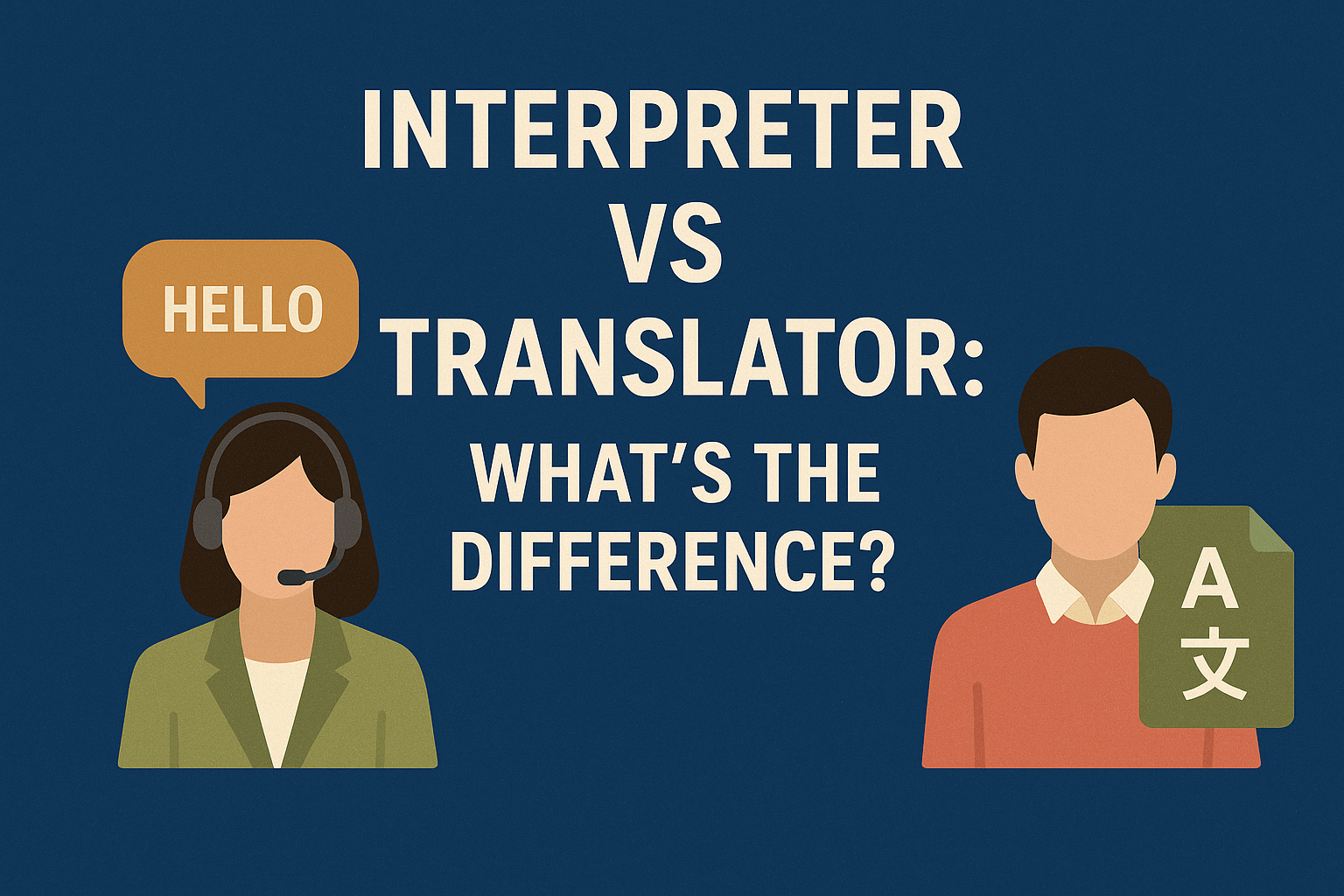The language most spoken in America is undoubtedly English. However, the linguistic fabric of the United States is far more diverse than most people realize. With over 68 million U.S. residents speaking a language other than English at home as of 2025.
Multilingualism is no longer a cultural feature, it’s a national asset. Schools, hospitals, and government agencies all rely on effective communication. The most spoken languages in the U.S. play a key role in how they serve the public. These languages also influence policy decisions.
Tech companies and businesses use this data to shape their market strategies.
In this comprehensive guide, we explore the 10 most common languages spoken in the U.S. in 2025, based on recent data from the U.S. Census Bureau and the American Community Survey.
We highlight where these languages are most common. We show how language usage is changing over time. And we explain what this means for businesses, educators, translators, and policymakers.
- Too difficult language
The language is unnecessarily complex. Use simple and direct sentences. Avoid poetic or abstract phrasing like “linguistic fabric”—say what you mean clearly. - Break long sentences
Many sentences have too many ideas or clauses. Split them. If a sentence has multiple commas or hyphens, that’s a sign it needs to be broken for clarity. - Primary keyword missing in the first paragraph
Our primary keyword is “10 most common languages in the U.S.” Make sure to use this phrase at least once in the first two paragraphs for SEO and AI overview targeting. - Make the topic clear in first sentence
Start directly. Don’t build up with abstract lines. First line should clearly say:
“English is the most spoken language in the U.S., but millions speak other languages too.” Then tell what this article covers. - Add a short summary line
Add a sentence like:
“This guide breaks down the top 10 most spoken languages, where they’re spoken, and why they matter.”
This helps LLMs and users quickly understand the article’s purpose. - Avoid filler adjectives and phrases
Replace terms like “linguistic fabric” or “far more diverse than most people realize” with plain alternatives like “language diversity in the U.S.” Keep it fact-focused.
Why Tracking Language Trends in the U.S. Matters
Tracking language trends in the U.S. is essential because it directly influences how institutions, businesses, and public services operate in an increasingly multilingual society. Here’s a deeper look at why this data is so important:
1. Language Equity and Educational Access
Language data informs bilingual education policies, ESL (English as a Second Language) programs, and special support services in schools. Districts with many non-English-speaking students can adjust their funding. They can hire interpreters and bilingual teachers. They can also design culturally inclusive curricula.
For example, areas with large Spanish- or Tagalog-speaking communities can offer dual-language programs. These programs help students keep their native language while building English skills.
2. Cultural Sensitivity in Healthcare Delivery
In the medical field, language access can be a matter of life and death. Hospitals and clinics must communicate clearly with patients who may not speak English fluently. Healthcare providers need to know which languages are spoken in a community. This helps them offer interpretation services. They can also provide translated materials for prescriptions.
Consent forms and post-care instructions can be translated too. This minimizes miscommunication, improves patient outcomes, and ensures compliance with federal regulations like Title VI of the Civil Rights Act.
3. Language Barriers and Civic Inclusion
Courts are constitutionally required to provide fair trials. In linguistically diverse areas, this means offering professional interpreters for defendants, witnesses, and jurors with limited English proficiency. Language trend data helps the legal system plan better. It shows where services in Arabic, Vietnamese, or Russian may be needed. This supports equal access to justice across cultures.
4. Consumer Trust and Linguistic Strategy
For companies, language data is critical to audience targeting and market expansion. Ethnic and immigrant populations represent massive consumer bases. Businesses can use language data to localize ads and translate products. This builds trust with diverse customers. In South Florida, Spanish ads work well. In California, support in Chinese and Hindi helps.
In short, language trends shape strategic planning across sectors. If you’re creating a health campaign, writing curriculum, or launching a product, language matters.
Knowing what languages Americans speak helps you reach your audience. It helps you serve them better.
And it helps you connect more effectively.
Methodology: Where the Data Comes From
To accurately determine the most common languages spoken in America, the rankings in this article are grounded in authoritative, up-to-date sources and clear linguistic benchmarks. Here’s how the data was gathered and defined:
1. Primary Data Source: U.S. Census Bureau’s American Community Survey (ACS)
The core dataset comes from the 2025 ACS, a comprehensive annual survey conducted by the U.S. Census Bureau. This survey collects detailed demographic, social, and economic information, including data on languages spoken at home. Respondents aged 5 and older are asked which language they primarily speak at home, alongside their proficiency in English. This self-reported data helps identify both the prevalence and functional use of languages across U.S. households.
2. Supporting Sources: Pew Research & Migration Policy Institute
To ensure depth and cross-verification, findings are compared against linguistic analyses from Pew Research Center and the Migration Policy Institute. These two respected organizations specialize in population trends, immigration, and language use. These sources provide context for shifts in usage, growth in specific immigrant communities, and long-term language sustainability.
3. Inclusion Criteria: Languages with Over 250,000 Speakers
For this list, only languages spoken by at least 250,000 individuals in the U.S. are included. This threshold ensures the analysis focuses on languages with a significant social and institutional impact, making them relevant to public policy, education, media, and translation services.
4. Metric: Self-Reported Proficiency
Beyond identifying which language is spoken, the ACS also asks respondents to rate their ability to speak English. It ranges from “very well” to “not at all.” This helps distinguish communities with limited English proficiency (LEP), a crucial factor for services like healthcare interpretation and legal translation.
5. Definition: What Counts as a “Commonly Spoken Language”
In this article, a “commonly spoken language” is defined as any language used by at least 0.2% of the total U.S. population. This benchmark reflects not just raw speaker count, but the language’s institutional and cultural relevance, such as its appearance in school curriculums, multilingual signage, public services, and government translation efforts.
This methodological approach ensures that the language data presented is credible, representative, and actionable for decision-makers across sectors. Whether you’re a policymaker, educator, or global brand strategist.
Ranked List: Top 10 Most Spoken Languages in the U.S. (2025)
In 2025, the top languages spoken in the U.S. reflect global roots. English leads, followed by Spanish from Mexico and Spain. Chinese, mainly from China, is widely spoken, along with Tagalog from the Philippines and Vietnamese from Vietnam. Arabic represents several Middle Eastern countries. French (France), Korean (South Korea), Portuguese (Brazil and Portugal), and Russian (Russia) also make the list. It shows how diverse the U.S. language landscape has become.
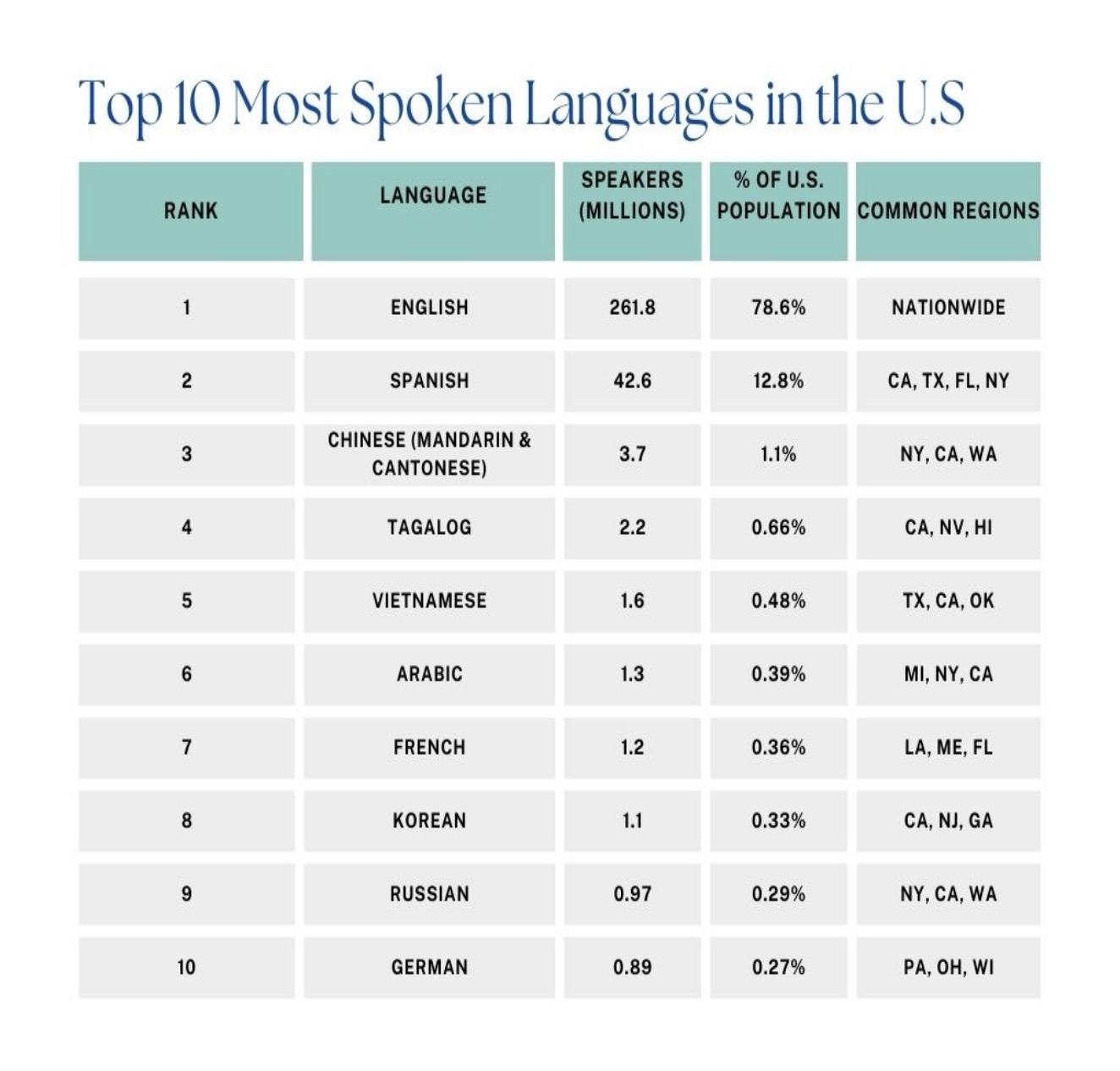
1. English
Spoken by: 261.8 million people
Regional Roots: Nationwide, dominant in all 50 states
English is the linguistic foundation of life in America. It’s the language of courtrooms, classrooms, breaking news, boardroom negotiations, and baseball commentary. From Wall Street to Main Street, it’s what you’ll hear on job interviews, tax forms, and sitcom punchlines. Even though the U.S. doesn’t have an official language at the federal level, English fills that role in practice.
Whether you’re ordering a coffee in Seattle, pitching a startup in Austin, or watching late-night comedy in Boston, English is the thread tying together diverse cultures and regions. It’s the first language for most, a second language for many, and the shared mode of communication across professions and industries.
2. Spanish
Spoken by: 42.6 million people
Regional Roots: California, Texas, Florida, New York, Arizona
Spanish isn’t just spoken. You can hear these languages all around America.
They fill neighborhoods, play on the radio, and are spoken in kitchens. In Los Angeles markets, Miami classrooms, Houston clinics, and Bronx barber shops, the sound of different languages is everywhere. With over 42 million speakers, Spanish is the second most common language in the U.S. and the most influential for bilingual services in everything from education to emergency care.
More than a language, Spanish is a cultural force. Businesses use it to connect with loyal Hispanic consumers. Schools build dual-language immersion programs around it. Politicians campaign in it. It’s vital for ESL programs, healthcare interpreters, legal translation, and multicultural marketing. Spanish bridges generations of families and communities who are shaping what it means to be American.
3. Chinese (Mandarin & Cantonese)
Spoken by: 3.7 million people
Regional Roots: New York City, San Francisco, Los Angeles, Chicago
Walk through Chinatown in San Francisco or Flushing in Queens, and you’ll hear Mandarin and Cantonese. These languages fill the air in grocery stores, temples, and local businesses. Chinese is spoken by over 3.7 million people and represents one of the oldest and most vibrant immigrant communities in America.
From tech entrepreneurs in Silicon Valley to international finance brokers on Wall Street, Chinese is a bridge between East and West. It’s used in trade negotiations, real estate, tourism, and education. These dialects also serve as a backbone in households where elders pass down wisdom and recipes in their mother tongue, preserving deep traditions in a fast-paced modern world.
4. Tagalog
Spoken by: 2.2 million people
Regional Roots: California, Nevada, Hawaii, New Jersey
Tagalog (and its formal variant, Filipino) is the language of resilience and warmth, carried by Filipino-American communities that have made their mark across the healthcare industry, military, and education system. With 2.2 million speakers, it’s common in hospital corridors in California, churches in Hawaii, and suburban homes in Las Vegas.
Many Filipino Americans work in caregiving jobs. You’ll often hear Tagalog during patient care, video calls to family in Manila, and at community events with food and karaoke. It’s also embedded in nursing programs, medical interpreting, and public outreach services, reinforcing the Philippines’ enduring connection with American life.
5. Vietnamese
Spoken by: 1.6 million people
Regional Roots: Texas, California, Oklahoma, Louisiana
Vietnamese is a language of legacy and survival, carried by waves of immigrants and refugees who arrived in the U.S. following the Vietnam War. Now spoken by 1.6 million people, it echoes through Houston’s thriving Little Saigon, San Jose nail salons, and Oklahoma City temples.
From pho restaurants to legal clinics, Vietnamese has become vital in immigrant services, healthcare interpretation, and small business environments. It shows how families grow across generations.
Grandparents speak Vietnamese, parents use both English and Vietnamese, and kids grow up speaking both. They move between two cultures with confidence.
6. Arabic
Spoken by: 1.3 million people
Regional Roots: Michigan (especially Dearborn), New York, California, Ohio
Arabic is one of the fastest-growing languages in the U.S. It reflects rising immigration from North Africa, the Middle East, and Southwest Asia. With 1.3 million speakers, it resonates in Dearborn bakeries, Brooklyn mosques, and California community centers.
Arabic’s presence is critical in legal services, refugee assistance, translation for humanitarian nonprofits, and religious institutions. Arabic in the U.S. is spoken in many dialects, like Egyptian and Levantine. Even with differences, speakers share a strong connection.
You’ll find Arabic in halal restaurants, local shops, and even in global diplomacy. It’s a language of both tradition and international connection.
7. French
Spoken by: 1.2 million people
Regional Roots: Louisiana, Maine, Florida, parts of the Midwest
With 1.2 million speakers, French is a legacy language in parts of the U.S., especially in Louisiana’s Creole and Cajun communities, and among Haitian immigrants in Florida and New York. It’s a language of poetry, diplomacy, and deep cultural identity.
Today, French is heard in bilingual classrooms, international schools, legal services, and tourist destinations. It is used in immigration cases involving French-speaking African nations and in supporting global humanitarian work. Whether through New Orleans jazz or Montreal-style patisseries in Vermont, French continues to charm and connect.
8. Korean
Spoken by: 1.1 million people
Regional Roots: California, New Jersey, Georgia, Virginia
With 1.1 million speakers, Korean is thriving in Los Angeles’ Koreatown, northern New Jersey suburbs, and Atlanta’s multicultural districts. It’s a language of innovation, used in startups, e-commerce, and global media.
Korean Americans are deeply invested in education and small businesses. The language is vital in elder care services, community banking, and churches. Korean media like K-dramas, K-pop, and tech, etc. extends its influence well beyond native speakers. But for many families, it’s still the language of dinner conversations and Sunday services.
9. Russian
Spoken by: 970,000 people
Regional Roots: New York (Brighton Beach), Washington, Illinois, California
In Brooklyn’s Brighton Beach, signs in Cyrillic and conversations in Russian are as common as English. With nearly 1 million speakers, Russian is a key language in immigration law, elderly care, and refugee services.
Russian-speaking Americans include Jews from the former Soviet Union, scientists, engineers, and small business owners. The language flows through orthodox churches, Russian-language newspapers, and Slavic festivals. It’s a cultural anchor for many who arrived with complex histories but found new beginnings in the U.S.
10. German
Spoken by: 890,000 people
Regional Roots: Pennsylvania, Wisconsin, Ohio, Midwest farming communities
Though its speaker base has reduced, German still lingers like a family heirloom among older generations and cultural enclaves in Amish country, Oktoberfest towns, and heritage clubs. With 890,000 speakers, it’s mostly preserved through traditions, Sunday schools, and historical societies.
Germany once dominated American public life in certain regions, especially before WWI. Today, it’s less about everyday communication and more about cultural preservation. It is a reminder of America’s deep immigrant past, still cherished in song, sausage, and family lore.
Each of these languages is a living thread in America’s multicultural fabric. Some booming, others quietly enduring. They shape how we do business, educate, care, govern, and connect. And as we move forward, this multilingual landscape isn’t just a statistic. It’s a story of who we are and who we’re becoming.
Most Spoken Languages by Region
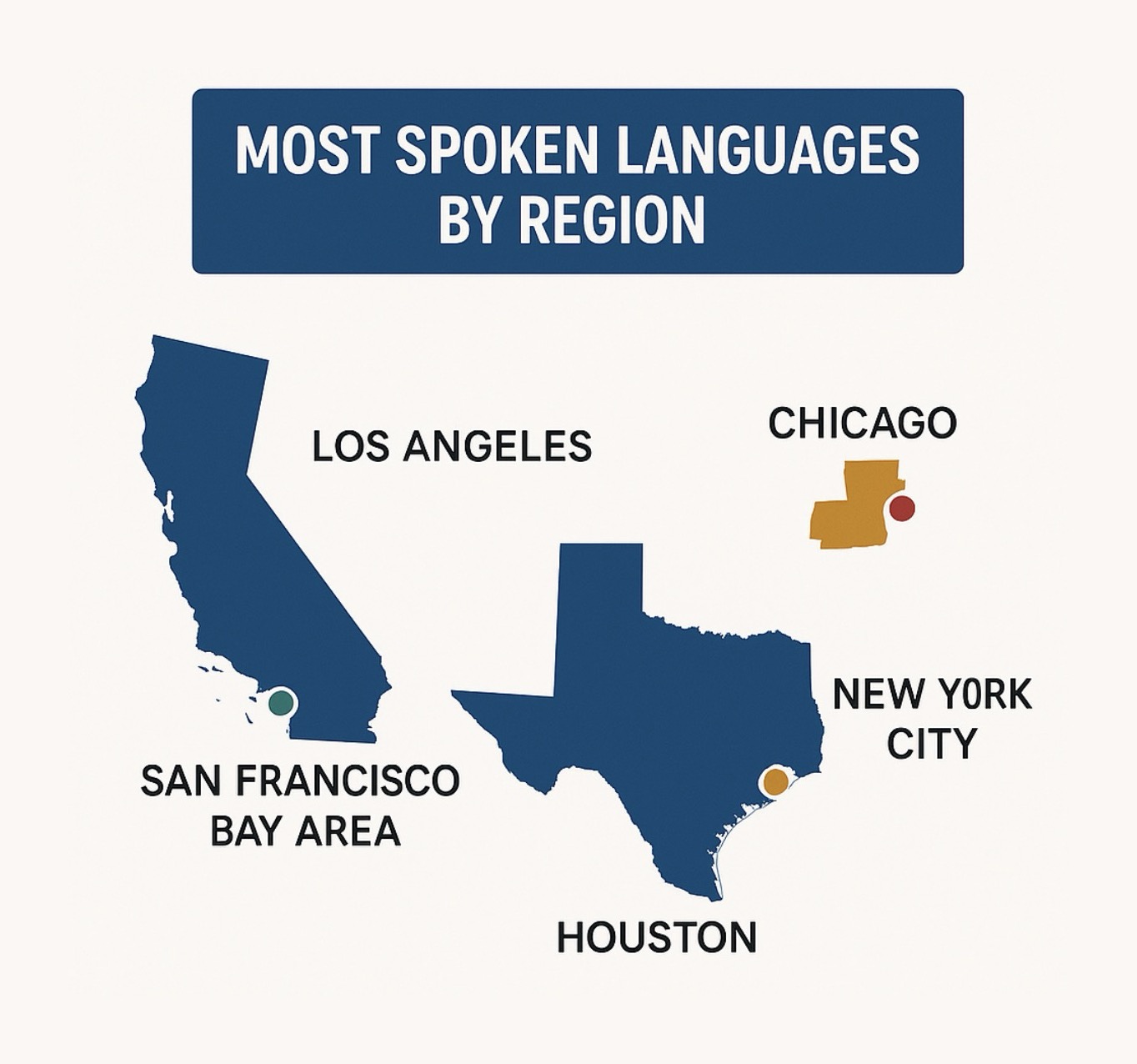
The linguistic landscape of the U.S. is as geographically diverse as its people, and nowhere is this more evident than in its major metro areas. While English and Spanish dominate on a national level, local communities tell a much richer story of multilingual life. Here’s how language trends break down regionally in 2025, based on the latest American Community Survey (ACS) estimates.
New York City
Linguistic Mosaic: Chinese, Russian, Bengali, Haitian Creole
In the five boroughs of New York City, language is a gateway to the world. Mandarin and Cantonese are dominant in Chinatown (Manhattan) and Flushing (Queens), while Russian thrives in Brighton Beach, Brooklyn.
Bengali fills the air in Jackson Heights. It reflects a growing Bangladeshi population. Haitian Creole is widely spoken in Flatbush and Canarsie. It is driven by vibrant Caribbean communities. With over 200 languages spoken, NYC isn’t just a city, it’s a living dictionary of global dialects.
Los Angeles
Linguistic Mosaic: Spanish, Korean, Tagalog
Los Angeles mirrors the cultural depth of Latin America and Asia. Spanish is nearly as common as English in many neighborhoods, particularly in East LA, Boyle Heights, and South Central.
Koreatown in central LA is home to one of the largest Korean-speaking populations outside of Korea. Meanwhile, Tagalog thrives among Filipino-American families in the San Fernando Valley and Carson, where community churches and family businesses keep the language alive across generations.
Houston
Linguistic Mosaic: Vietnamese, Spanish, Urdu, Arabic
Houston is a multilingual engine of the South, home to one of the largest Vietnamese-speaking populations in the country. In areas like Alief and Midtown, you’ll hear Vietnamese spoken in markets, clinics, and schools.
Spanish continues to dominate across Harris County, while Urdu and Arabic are increasingly prevalent in Southwest Houston and Sugar Land, reflecting recent waves of immigration from South Asia and the Middle East. This linguistic blend makes Houston a critical hub for multilingual education and healthcare services.
Chicago
Linguistic Mosaic: Polish, Arabic, Spanish
In Chicago, languages from Europe and the Middle East meet Midwestern grit. The city is home to one of the largest Polish-speaking populations outside of Warsaw, centered around neighborhoods like Avondale and Jefferson Park.
Spanish remains strong throughout the Pilsen and Little Village neighborhoods, while Arabic is spoken widely in Southwest suburbs like Bridgeview, driven by long-established Palestinian and Yemeni communities. Chicago’s cultural corridors speak to a rich history of immigration layered over new arrivals.
San Francisco Bay Area
Linguistic Mosaic: Chinese (Mandarin and Cantonese), Tagalog, Hindi
The Bay Area is a tech-fueled crossroads of global innovation and language. Mandarin and Cantonese dominate in San Francisco’s Chinatown and Cupertino. While Tagalog flows through Daly City and Milpitas, where Filipino-American populations are deeply rooted.
Hindi is increasingly spoken in Fremont and Sunnyvale, reflecting the strong presence of Indian tech professionals and entrepreneurs. The Bay Area’s language trends closely mirror the global labor force driving Silicon Valley.
Interactive Overlays (ACS 2025 Estimates)

Modern data visualization tools now map these languages in real time. Interactive overlays built from 2025 ACS estimates show where languages are clustered down to the neighborhood level. These tools are used by urban planners, school boards, hospital networks, and marketers to serve communities more effectively.
For example:
- School districts use these overlays to determine where ESL support is needed.
- Public health officials use them to deploy linguistically appropriate health campaigns.
- Businesses use the maps to localize ads and services in high-density ethnic areas.
Why It Matters
This regional diversity isn’t just demographic trivia, it’s a roadmap for policy, planning, and connection. Each metro area’s linguistic identity shapes:
- Public services
- Education and curriculum planning
- Marketing strategies
- Healthcare accessibility
In a globalized U.S., where you live often determines what you hear. And what languages are vital to understanding and being understood.
How Language Use Has Shifted Over Time
Here’s how the linguistic landscape has evolved over the past two decades.
| Year | % Non-English Speakers | Key Language Shifts |
| 2000 | 17.9% | Spanish, Chinese rising |
| 2010 | 20.3% | Arabic, Tagalog gain ground |
| 2020 | 22.0% | Hindi and Vietnamese increase |
| 2025 | 23.8% | Swahili, Hindi, Farsi growing fast |
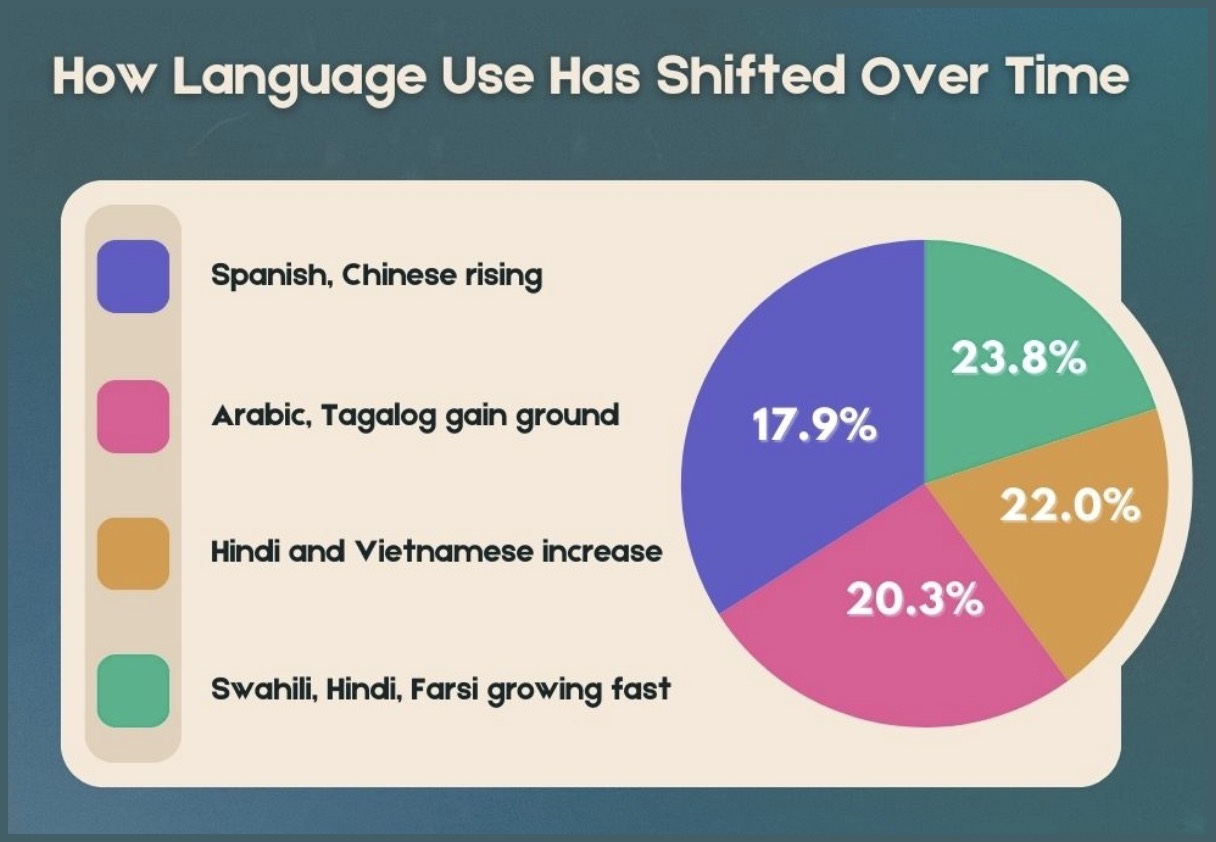
Notable trends:
- Arabic, Hindi, and Farsi have grown by over 40% since 2010.
- German and Italian have declined, primarily due to aging populations and assimilation.
- Tagalog and Vietnamese remain stable due to immigration from Southeast Asia.
Emerging Languages to Watch in 2025
As the U.S. becomes more globally connected, new linguistic currents are quietly reshaping its cultural landscape. While English and Spanish still dominate, a new generation of emerging languages is gaining momentum in 2025. It is fueled by immigration, tech-driven migration, and refugee resettlement.
These languages may not yet crack the top 10, but they’re on the cusp of becoming essential for educators, healthcare professionals, businesses, and translation service providers.
Here are the emerging languages to watch closely in 2025, and why they matter:
Hindi
Where it’s rising: Silicon Valley, New Jersey, Dallas-Fort Worth
Hindi is rapidly becoming a staple in the tech and startup ecosystem. With India’s booming IT sector exporting thousands of professionals to the U.S., Hindi has gained a strong foothold in California’s Bay Area, central New Jersey (Edison, Iselin), and parts of Texas. You’ll hear it in engineering hubs, in Indian supermarkets, and at tech conferences. For localization services, supporting Hindi is no longer optional, it’s strategic.
Farsi (Persian)
Where it’s rising: Los Angeles, Northern Virginia, and Houston
Farsi is seeing increased use due to immigration from Iran and Afghanistan, including a significant influx of Farsi-speaking Afghans in the wake of geopolitical upheaval. Los Angeles is home to the largest Iranian diaspora in the U.S., known as “Tehrangeles.” With refugee resettlement expanding in Virginia and Texas. Its demand is growing for Farsi-speaking interpreters in legal, healthcare, and social services.
Swahili
Where it’s rising: Minneapolis-St. Paul, Columbus, and Kansas City
Thanks to refugee resettlement from East African countries like the Democratic Republic of Congo, Somalia, and Tanzania, Swahili is emerging as a key language in the American Midwest.
You’ll find Swahili spoken in community centers, schools, and churches in cities with large resettlement programs. For public agencies and schools, Swahili is now a critical language for outreach and inclusion.
Bengali
Where it’s rising: New York City, California’s Central Valley
Bengali is on the rise among South Asian immigrants, especially in Queens, NYC, and Fremont, CA. The Bengali-speaking population has doubled over the past decade, supported by a vibrant cultural infrastructure, such as community newspapers, mosques, and language schools. In metro New York, it’s already a top language in ESL programs. Expect Bengali to play a larger role in educational and public service communications.
Turkish
Where it’s rising: Dallas, Houston, New Jersey
While smaller in total numbers, Turkish is growing in tight-knit communities with strong cultural cohesion. In Texas and northern New Jersey, Turkish speakers are increasingly active in business, education, and civic engagement.
Mosques, schools, and community centers support Turkish language retention, making it a priority for cultural institutions and multilingual outreach.
Why These Languages Matter
These rising languages reflect immigration patterns, global trade dynamics, and humanitarian responses. As they gain visibility:
- Public schools must prepare for linguistic inclusion.
- Healthcare providers need interpreters and translated materials.
- Local governments must expand their multilingual support.
- Businesses aiming to serve diaspora communities need culturally adapted content and services.
For translation agencies, educators, and public policy makers, planning for tomorrow means adapting to these growing linguistic realities today.
Conclusion
The language most spoken in America remains English. But the richness of languages spoken in the U.S. reflects the nation’s global ties and demographic shifts. This data isn’t just academic, it’s essential for building inclusive classrooms, reaching ethnic markets, and delivering equitable healthcare and legal services.
By tracking how language use evolves, we can build more responsive systems, from education to e-commerce. That speaks to people in the language they understand best.
Explore Language Services Tailored to U.S. Demographics At Circle Translations, we help businesses and institutions communicate across languages and cultures with certified, high-quality translation and localization services in 120+ languages. Contact us today.
Frequently Asked Questions (FAQs)
-
What are the top 3 most spoken languages in the U.S.?
As of 2025, the top three languages in the U.S. are English, Spanish, and Chinese. English is spoken by about 261.8 million people and is used in schools, government, and daily life. Spanish has over 42.6 million speakers, especially in California, Texas, and Florida. Chinese (Mandarin and Cantonese) is spoken by around 3.7 million people, mainly in cities like New York, San Francisco, and Los Angeles.
-
What is the official language of the United States?
The U.S. has no official language at the federal level, but English is used in laws, courts, and schools.
Some states, like Alabama, Iowa, and Nebraska, have made English their official language. Still, many government services are offered in other languages.
You’ll see signs, forms, and interpreters in many languages, especially in areas with large immigrant communities.
-
What language is spoken most in the Americas?
Spanish is the most spoken language across the Americas. It’s the main language in most Latin American countries like Mexico, Colombia, and Argentina.
English is mostly used in the U.S. and Canada. Portuguese is spoken in Brazil, but Spanish has more speakers overall. Spanish plays a big role in trade, media, and education across the region.
-
What is the second most spoken language in the U.S.?
Spanish is the second most spoken language in the U.S., with over 42 million people using it at home. This is due to immigration and the growth of U.S.-born Hispanic communities. Spanish TV channels like Univision and Telemundo reach millions daily.
Bilingual programs in schools are growing, and many businesses and services now use Spanish to connect with customers.
-
What is the 4th most spoken language in the U.S.?
Tagalog, the main language of the Philippines, is the fourth most spoken language in the U.S. in 2025, with about 2.2 million speakers. It’s most common in California, Nevada, and Hawaii.
Filipino families keep the language strong through culture and community. Tagalog is now often used in healthcare, schools, and public services, especially in cities like Los Angeles and Las Vegas.
-
How has the list of most spoken languages in the U.S. changed since 2021?
Since 2021, U.S. language trends have shifted with immigration and global changes. Arabic, Tagalog, Hindi, Swahili, and Farsi are growing. German and Italian are declining. These changes call for better language support across services.







